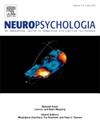Cortical visual processing differences in myopia and blur
IF 2
3区 心理学
Q3 BEHAVIORAL SCIENCES
引用次数: 0
Abstract
Myopia is projected to impact over 50 % of the global population by 2050. Despite links to long-lasting anatomical changes in visual cortices, little is known of potential consequences of myopia on visual brain functions, such as visual completion. We hypothesized that adults suffering from moderate myopia process attentionally demanding visual stimuli under optical blur differently than emmetropic adults. Non myopes (N = 12) and low-to-mild myopes (N = 13) were tested under −3 diopters of lens-induced blur. Participants performed an illusory contour discrimination task while 128-channel EEG was recorded. Each trial also included an intervening, task-irrelevant dartboard stimulus. Visual evoked potentials (VEPs) to the illusory contour (IC), no contour (NC), and dartboard stimuli were analyzed using an electrical neuroimaging framework. We provide evidence for cortical processing differences between non myopes and mild myopes at 218–280ms post-stimulus during visual completion, but not during viewing of dartboards. These differences stemmed from topographic modulations, indicative of the engagement of distinct networks of brain regions that were localized to medial portions of the occipital pole. Moreover, the predominant VEP topography during this time period both correlated with extent of refractive error, and also was an excellent classifier of myopia vs. emmetropia. By contrast, our analyses provided no evidence for differences in visual completion processes between groups. To our knowledge, this is the first study of myopia pairing high-density EEG and a behavioral task. Collectively, this pattern of findings supports a model of myopia wherein low-level visual cortices are impacted at relatively late post-stimulus processing stages.
近视和模糊的皮层视觉加工差异
预计到2050年,近视将影响全球50%以上的人口。尽管近视与视觉皮层的长期解剖变化有关,但人们对近视对视觉脑功能(如视觉完成)的潜在影响知之甚少。我们假设中度近视的成人在视觉模糊下处理注意力要求的视觉刺激的过程与近视的成人不同。非近视眼(N = 12)和低至轻度近视眼(N = 13)在- 3屈光度透镜引起的模糊下进行测试。被试在记录128通道脑电图的同时进行错觉轮廓识别任务。每个试验还包括一个干预的、与任务无关的飞镖刺激。使用电神经成像框架分析了虚幻轮廓(IC)、无轮廓(NC)和飞镖靶刺激的视觉诱发电位(vep)。我们提供了非近视眼和轻度近视眼在刺激后218-280ms的皮层加工差异的证据,但在观看飞镖时没有。这些差异源于地形调节,表明大脑区域的不同网络的参与,这些网络定位于枕极的内侧部分。此外,这一时期的主要VEP地形既与屈光不正程度相关,也可以作为近视和远视的优秀分类指标。相比之下,我们的分析没有提供证据表明各组之间的视觉完成过程存在差异。据我们所知,这是第一次将高密度脑电图与行为任务配对的近视研究。总的来说,这一发现模式支持了近视的模型,其中低水平视觉皮层在相对较晚的刺激后加工阶段受到影响。
本文章由计算机程序翻译,如有差异,请以英文原文为准。
求助全文
约1分钟内获得全文
求助全文
来源期刊

Neuropsychologia
医学-行为科学
CiteScore
5.10
自引率
3.80%
发文量
228
审稿时长
4 months
期刊介绍:
Neuropsychologia is an international interdisciplinary journal devoted to experimental and theoretical contributions that advance understanding of human cognition and behavior from a neuroscience perspective. The journal will consider for publication studies that link brain function with cognitive processes, including attention and awareness, action and motor control, executive functions and cognitive control, memory, language, and emotion and social cognition.
 求助内容:
求助内容: 应助结果提醒方式:
应助结果提醒方式:


